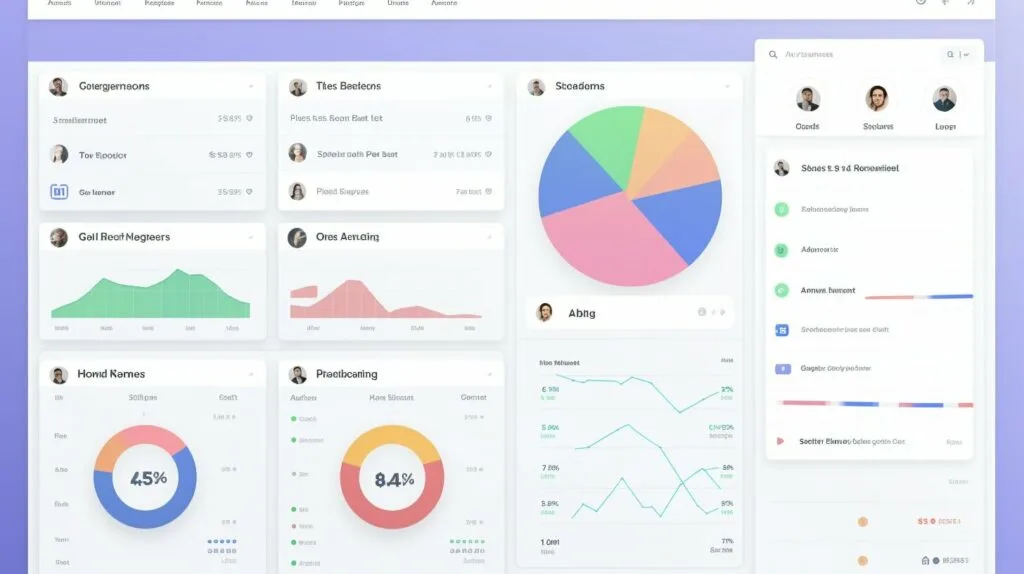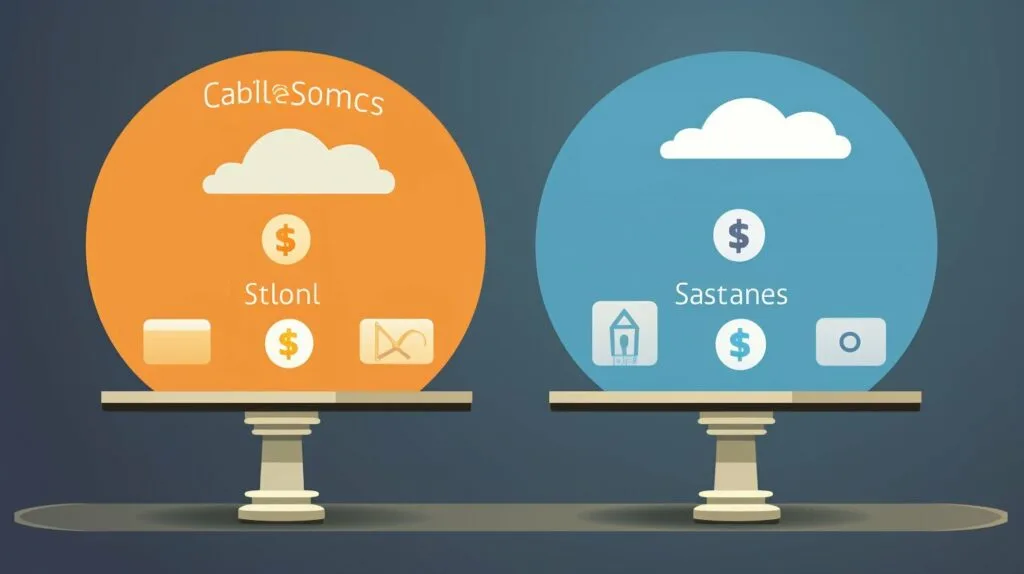Software as a service, commonly known as SaaS, has transformed the way businesses operate in recent times. Unlike traditional software licensing models, SaaS provides a cloud-based solution that enables businesses to access software applications over the internet, with no hardware installations or maintenance required.
SaaS business model has a recurring revenue model, where customers pay a monthly or yearly subscription fee to keep using the software. This makes it a cost-effective solution for businesses of all sizes, as they can avoid the high upfront costs of traditional software and only pay for what they need.
SaaS solutions are gaining increasing popularity among businesses due to their flexibility, scalability, and ease of use. They offer a wide range of benefits to both the provider and the customer, including cost savings, seamless updates, and accessibility from any device with an internet connection.
In this article, we will explore the SaaS business model in detail, discussing its key components, benefits, challenges, and future trends. We will also provide real-world examples of successful SaaS companies and offer guidance on factors to consider when choosing a SaaS provider.
Key Takeaways:
- SaaS provides a cloud-based solution that enables businesses to access software applications over the internet.
- SaaS has a recurring revenue model, where customers pay a monthly or yearly subscription fee to keep using the software.
- SaaS solutions offer cost savings, seamless updates, and accessibility from any device with an internet connection.
Understanding the SaaS Business Model
The SaaS business model is a software delivery model where a third-party provider hosts applications and makes them available to customers over the internet. Unlike traditional software licensing models, SaaS providers allow customers to access their software through a subscription-based service, usually on a monthly or annual basis.
Software as a Service (SaaS) has been around for over a decade and has quickly evolved into a multibillion-dollar industry. The rise of cloud computing and advancements in internet technology have played a huge role in the growth of the SaaS business model.
Software as a Service (SaaS)
The SaaS business model is based on the concept of Software as a Service (SaaS), a delivery model where software is provided over the internet instead of being installed on a local computer. This means that customers can access the software from anywhere in the world with an internet connection, without having to worry about maintaining and updating the software themselves.
With SaaS, the provider takes care of everything from hosting and maintenance to security and software updates. This makes it an attractive option for businesses who want to focus on their core operations rather than managing IT infrastructure.
Moreover, SaaS providers usually offer a pay-as-you-go subscription model, which means businesses only pay for the software they use. This makes it a cost-effective solution for businesses of all sizes, especially those that want to avoid the upfront costs associated with traditional software licensing models.
Key Components of a SaaS Business Model
A SaaS business model typically comprises several essential components that work together to facilitate the delivery of software as a service. In this section, we will explore the key components that make up a successful SaaS business model.
Pricing Strategies
One of the primary appeals of the SaaS business model is its pricing flexibility. SaaS companies typically offer several pricing plans to cater to the diverse needs of their customers. For instance, some providers may offer a pay-as-you-go model, while others may charge a fixed monthly or annual fee. In addition, businesses may have different tiers of service levels that cater to different needs or offer customized pricing for enterprise solutions.
Recurring Revenue Model
SaaS businesses generate revenue through ongoing subscriptions from their customers. The recurring revenue model provides a stable cash flow and long-term sustainability for the provider. The revenue generated from subscriptions can be invested in product development, customer service, and marketing to help grow the business.
Customer Acquisition and Retention
Acquiring and retaining customers is crucial for the success of any SaaS business. Providers must invest in marketing and sales strategies that resonate with their target customers. Additionally, customer retention strategies such as providing excellent customer service, continuous product improvement, and personalized support can help businesses retain their customers.
Scalability
The scalability of a SaaS business model is vital, as it allows providers to handle an increasing number of customers without negatively impacting the quality of service. SaaS companies leverage cloud-based infrastructure to scale their business quickly while keeping costs low. Additionally, SaaS businesses can develop their solutions in a way that allows them to add new features and customize their offerings to meet the evolving needs of their customers.

“SaaS businesses generate revenue through ongoing subscriptions from their customers. The recurring revenue model provides a stable cash flow and long-term sustainability for the provider.”
Benefits of a SaaS Business Model
The SaaS business model offers various benefits to businesses and customers alike. Here are some advantages:
| Benefits | Description |
|---|---|
| Cost savings | SaaS eliminates the need for costly hardware and software licenses, reducing upfront expenses and ongoing maintenance costs. |
| Flexibility | Built for scalability, SaaS allows businesses to add or remove users and features according to their changing needs, making it a flexible and cost-effective solution. |
| Seamless updates | SaaS providers handle updates and maintenance on their end, ensuring that customers receive the latest features and security upgrades without any downtime or interruptions. |
| Accessibility | SaaS applications are accessible from anywhere with an internet connection, allowing users to work remotely and collaborate in real-time. |
According to a report by Gartner, the global SaaS market is expected to reach $117.7 billion by the end of 2021, indicating the growing importance and acceptance of this business model. Real-world case studies highlight the benefits of SaaS for businesses of all sizes and industries.
“Gusto, a cloud-based payroll and HR software provider, has reported more than 60% year-over-year revenue growth since adopting a SaaS business model. The flexibility and scalability of the SaaS model has allowed Gusto to expand operations, support a growing customer base, and remain profitable.”
Similarly, cloud-based project management tool Asana has experienced significant growth due to its SaaS offering. With over 3 million users across 190 countries, Asana’s user-friendly interface and seamless updates have made it a popular choice for businesses looking to streamline workflows and increase productivity.

SaaS Business Model Examples
Several SaaS companies have successfully leveraged the model to deliver innovative solutions to customers. These examples show how the SaaS business model is being used in different industries.
1. Salesforce
Salesforce is a well-known leader in the CRM industry, providing cloud-based software that helps businesses manage customer relationships. With a subscription-based model, Salesforce has grown rapidly and now boasts over 150,000 customers worldwide. Their innovative solutions and commitment to customer success have made them a popular choice for businesses big and small.

2. Zoom
Zoom is a video conferencing and collaboration tool that has become essential for remote teams. Their easy-to-use platform and reliable service have garnered millions of users worldwide. With a free basic plan and affordable pricing options for upgraded features, Zoom has disrupted the traditional video conferencing market and dominated the space.

3. Asana
Asana is a project management tool that helps teams stay organized and on track. Their SaaS model allows for seamless collaboration and task management, making it a popular choice for teams across industries. Asana’s commitment to user experience and innovative features have helped them scale rapidly and attract a loyal customer base.

These are just a few examples of the many successful SaaS businesses out there. By delivering cost-effective solutions that are accessible and scalable, these companies are changing the way businesses operate in the digital age.
Building a Sustainable SaaS Business
Building a sustainable SaaS business requires a strategic approach that focuses on long-term growth and customer satisfaction. Here are some key considerations and strategies that can help:
1. Prioritize Product-Market Fit
Product-market fit is a critical factor in the success of any SaaS business. It involves understanding your target audience and their needs and ensuring that your product or service meets those needs effectively. To achieve product-market fit, businesses need to conduct market research, analyze customer feedback, and continuously improve their offerings based on the insights gained.
2. Implement Customer Feedback Loops
Customer feedback loops are essential for keeping up with customer needs and preferences. By soliciting feedback through surveys, reviews, and other means, businesses can gain valuable insights that can inform product development, marketing, and customer support. Responding to feedback in a prompt and transparent manner also helps to build trust with customers and establish a reputation for excellent customer service.
3. Emphasize Continuous Improvement
Continuous improvement is a core principle of the SaaS business model. Businesses must be committed to ongoing innovation and improvement to stay ahead of the competition and meet evolving customer needs. This involves investing in research and development, staying abreast of industry trends, and always looking for ways to enhance the user experience.

4. Maintain High Levels of Customer Satisfaction
Customer satisfaction is the foundation of a sustainable SaaS business. Businesses must ensure that their customers are happy with their offerings and receive prompt and effective support when needed. This involves setting clear expectations, delivering on promises, and being responsive to customer inquiries and concerns. By prioritizing customer satisfaction, businesses can build a loyal customer base and reduce churn.
5. Leverage Scalability for Growth
Scalability is one of the primary advantages of the SaaS business model. By leveraging cloud-based infrastructure and automation tools, businesses can easily scale their operations to meet growing demand. However, achieving scalable growth requires careful planning and execution. Businesses need to anticipate future growth and invest in the resources and infrastructure needed to support it.
By following these strategies and considerations, businesses can build sustainable SaaS models that drive long-term growth and profitability.
Challenges of the SaaS Business Model
As the SaaS industry continues to grow and evolve, businesses operating under this model face a range of challenges that can impact their success. Here are some of the most common hurdles that SaaS companies need to overcome:
| Challenge | Solution |
|---|---|
| Competition: With the increasing number of players in the SaaS market, competition is becoming fiercer. | Develop a unique value proposition, focus on customer needs, and continuously improve product offerings to stand out from competitors. |
| Customer churn: SaaS companies face the challenge of retaining customers in a highly competitive market. | Provide exceptional customer service, offer personalized solutions, and continuously monitor customer feedback to address concerns and improve satisfaction. |
| Security concerns: With sensitive data stored in the cloud, security is a top priority for SaaS businesses. | Invest in robust security measures, comply with industry regulations, and communicate with customers about data privacy and protection. |
| Pricing pressure: SaaS companies need to price their offerings competitively while still making a profit. | Conduct market research to determine optimal pricing strategies, offer flexible pricing plans, and regularly review pricing to ensure profitability. |
| Scalability issues: As demand for SaaS solutions grows, businesses need to ensure that their infrastructure can keep up. | Invest in scalable technology and processes, monitor system performance, and regularly evaluate capacity needs and opportunities for expansion. |
Despite these challenges, the rewards of a successful SaaS business model are significant, making it important for companies to develop strategies to overcome these obstacles and achieve sustainable growth.

The Future of SaaS Business Model
The SaaS industry has already witnessed significant growth in recent years, but the future looks even brighter. Companies will continue to adopt SaaS solutions as they offer more flexibility, scalability, and cost-effectiveness than traditional software models.
One prominent trend is the increasing use of artificial intelligence (AI) and machine learning in SaaS products. These technologies can help automate tasks, improve analytics, and enhance customer experiences.
Another trend is the emergence of specialized niche SaaS products that cater to specific industries or functions. This will help businesses find more tailored and customized solutions that can better address their unique needs.
The SaaS industry will also see a rise in cloud-based solutions that can be accessed from anywhere at any time. This will enable businesses to be more agile, mobile, and responsive, while reducing the burden on IT infrastructure.
Overall, the future of the SaaS business model looks promising, with continued innovation, growth, and value creation for businesses and customers alike.

SaaS Business Model vs. Traditional Software Licensing Models
When considering software options for their business, companies must choose between traditional software licensing models and the SaaS business model. While both options have their advantages and disadvantages, SaaS is becoming increasingly popular for a variety of reasons.
Advantages of the SaaS Business Model
SaaS offers several advantages over traditional software licensing models. First, SaaS providers typically offer a pay-as-you-go pricing model, allowing companies to scale their usage up or down as needed without incurring additional costs. Additionally, SaaS solutions are typically easier to implement and access, as they require no on-premises installation and can be accessed via the internet from any device.
SaaS also offers seamless updates, with providers constantly updating their software to ensure it runs smoothly and securely. Finally, SaaS providers often offer robust customer support and training, making it easier for companies to onboard and train employees on the new software.
Limitations of Traditional Software Licensing Models
While traditional software licensing models have been the norm for many years, they do have several limitations. First, licensing fees can be expensive, particularly for large organizations with many employees. Additionally, traditional software often requires on-premises installation, which can be time-consuming and costly.
Finally, traditional software is often slower to update, as companies must wait for new releases to be developed and distributed. This can result in security vulnerabilities and compatibility issues with other software.
Overall, while traditional software licensing models may still be appropriate for some companies, the benefits of the SaaS business model are difficult to ignore.

Factors to Consider When Choosing a SaaS Provider
Choosing the right SaaS provider is crucial to the success of your business. When evaluating potential providers, consider the following factors:
- Reliability: Ensure that the provider has a track record of delivering high uptime and consistent service. Look for guarantees of reliability and disaster recovery plans.
- Security: The security of your data should be a top priority. Make sure the provider uses the latest security technologies and protocols, and comply with industry-standard security certifications and regulations.
- Scalability: As your business grows, your SaaS solution should be able to scale with you. Check if the provider can accommodate your changing needs and offer flexible pricing plans.
- Customer Support: Look for a provider that offers responsive and knowledgeable customer support. Check the hours of availability, support channels, and average response times.
- Pricing Models: Consider the pricing models offered by the provider, such as subscription-based, pay-per-use, or freemium. Choose the one that best fits your budget and aligns with your business goals.
By carefully evaluating these factors, you can select a SaaS provider that meets your business needs and supports your growth and success.

Conclusion
As businesses continue to digitize and move operations to the cloud, the Software as a Service (SaaS) business model has emerged as a popular and effective solution. By offering software applications as a service rather than a product, businesses can enjoy a range of benefits, from cost savings to scalability.
Throughout this article, we have explored the key components of a SaaS business model, its benefits, challenges, and future growth potential. We have also highlighted examples of successful SaaS companies across multiple industries, showcasing the practical application of this model in the real world.
While the SaaS business model is not without its challenges, businesses that invest in building a sustainable model can enjoy long-term success and growth. By carefully choosing a reliable and trustworthy SaaS provider and remaining vigilant about customer satisfaction and feedback, businesses can ensure they maximize the potential of the SaaS model.
In conclusion, the SaaS business model is a powerful tool for businesses looking to improve efficiency, reduce costs, and stay ahead of the competition in the digital age. By embracing this model and its potential, businesses can unlock a range of opportunities and benefits that can help them achieve sustained success in the long run.
FAQ
Q: What is a SaaS business model and how does it work?
A: The SaaS (Software as a Service) business model is a software distribution model where software is provided as a service over the internet. Instead of purchasing and installing software on individual computers, users can access and use software applications through a web browser. Users typically pay a subscription fee for the software, which is hosted and maintained by the SaaS provider.
Q: What are the key components of a SaaS business model?
A: The key components of a SaaS business model include pricing strategies, recurring revenue model, customer acquisition and retention, and scalability. SaaS companies often use subscription-based pricing models, which allow customers to pay a recurring fee for access to the software. This recurring revenue model provides a steady stream of income for the SaaS provider. Customer acquisition and retention are also important components, as SaaS companies need to attract and retain customers to ensure ongoing revenue. Finally, scalability is crucial for SaaS businesses to handle increased demand and accommodate growing customer bases.
Q: What are the benefits of a SaaS business model?
A: The SaaS business model offers several benefits for both providers and customers. Providers can enjoy cost savings by offering software as a service, as they do not have to produce physical copies or distribute software individually. Customers benefit from the flexibility of accessing software from anywhere with an internet connection, seamless updates and upgrades, and lower upfront costs compared to traditional software licensing models.
Q: Can you provide some examples of successful SaaS companies?
A: Sure! Some examples of successful SaaS companies include Salesforce, which offers cloud-based customer relationship management (CRM) software, Slack, a popular collaboration tool, and Trello, a project management platform. These companies demonstrate the practical application and success of the SaaS business model in various industries.
Q: What are the challenges of the SaaS business model?
A: While the SaaS business model offers many advantages, it also comes with challenges. These challenges may include competition within the market, customer churn, security concerns, pricing pressure, and scalability issues. SaaS businesses must navigate these obstacles and develop strategies to overcome them.
Q: How does the SaaS business model compare to traditional software licensing models?
A: The SaaS business model differs from traditional software licensing models in several ways. Instead of purchasing software upfront, SaaS customers pay a recurring fee for access. Updates and upgrades are typically handled by the SaaS provider, eliminating the need for manual installations. The SaaS model also allows for greater flexibility and accessibility since software can be accessed from any internet-connected device. Traditional software licensing models often involve higher upfront costs and less frequent updates.
Q: What factors should be considered when choosing a SaaS provider?
A: When choosing a SaaS provider, it is important to consider factors such as reliability, security measures, scalability options, customer support, and pricing models. Reliability ensures that the software is consistently available and performs well. Data security is crucial to protect sensitive information. Scalability options allow the software to grow with your business needs. Customer support should be responsive and helpful. Finally, pricing models should be transparent and align with your budget and usage requirements.
Q: What does the future hold for the SaaS business model?
A: The future of the SaaS business model looks promising, with emerging technologies and evolving customer expectations driving innovation in the industry. As businesses increasingly embrace digital transformation, the demand for SaaS solutions is expected to grow. However, potential disruptions and challenges may also arise, making it essential for businesses to stay informed and adapt to changing trends.

